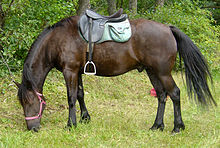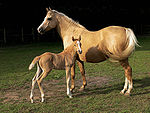- Auvergne horse
-
Auvergne horse 
Auvergne horseAlternative names Cheval d'Auvergne (French) Country of origin Auvergne region of France Breed standards Association Nationale du Cheval de Race Auvergne Breed standards Horse (Equus ferus caballus) The Auvergne horse (French cheval d'Auvergne) is a breed of light draught horse from the Auvergne region of south central France. It stands 143 to 147 centimetres (14.0 to 14.2 hands) at the withers, and weighs 450–650 kilograms (990–1,400 lb).[1] Coat colours are bay or seal brown. It is used mainly for trekking. It is not recognised as a breed by the Haras Nationaux, the French association of horse breeders.[2] The standard is published by a breeders' association, the Association Nationale du Cheval de Race Auvergne.
This breed has been crossbred several times throughout its history, with several distinct breeds sharing the name "Auvergne horse". A small riding horse known as the "half-blood of Auvergne" was primarily ridden by the calvary at the beginning of the 19th century, but has since disappeared. Other work horses of Auvergne were used as a means of transportation before the advent of modern roads. The work horse was crossbred to become a light draught horse and subsequent ancestor of the modern Auvergne horse. It was used for varying field work by the inhabitants of the region.
As with most of Europe's draught breeds, the Auvergne almost disappeared with the spread of mechanized transportation in the 1960s and 70s. It was crossed with other draught horses, such as the Comtois horse, and was used as a source of horsemeat. In 1994, an association was created to save the last remaining animals and to fight for the recognition of the breed in France. Since then, several actions have been levied to promote the continued existence of the Auvergne horse. However, the breed is still extremely rare outside of Auvergne. 200 were represented in a census at the beginning of the 21st century.
Contents
History
As with other local draught horses, the use of the Auvergne horse has declined with the rise of mechanized travel.[3] Defining the horse is difficult in the absence of recent scientific publications and official recognition. Documents mentioning the "cheval d'Auvergne" in fact speak of many different breeds which have rarely, or never, been recognized as an independent breed throughout their history.
Origin
No scientific studies exist concerning the origin of the Auvergne horse, but there are several theories:
- According to the Association of the Auvergne Breed, the breed is the distant descendant of the oriental races abandoned by the Saracens in the plains of Vouillé circa 732. Their horses remained in the same area (the departments of Corrèze, of Creuse, and of Haute-Vienne) until the barons of the country took possession of them. The horses would presumably been the root of those which had spread over the course of the following centuries into all of Limousin, followed by Auvergne, to become the ancestors of the Limousin horse, a close relative of the Auvergne horse.[3][4]
- According to Lætitia Bataille, a specialist in equine managment in France, the Auvergne horse was the product of the ancient Navarrin horse's crossbreeding with the Thoroughbred.[2]
- According to the inhabitants of the Auvergne region, the breed is native to the region, and lived there "depuis la nuit des temps" (since the dawn of time.) According to their theory, it is descended from prehistoric animals who had simply wandered into the region.[5]
There seems to have been two types of Auvergnal horses throughout the region's history: the smaller horse, or "half-blood Auvergnal", was a riding horse destined to the light cavalry; the common, "all-purpose" horse was used by locals until the improvement of automobile roads, at which time it was crossbred again to better handle divers agricultural duties.[6]
Antiquity to 17th century
If one believes the inhabitants of Auvergne, Vercingetorix used a "Auvergnat cob" for his battles.[5] True or not, the Auvergne horse seems to have been popular in the Middle Ages.[7]
In 1577, the Duke of Bouillon mentions, in an Classical French text, that he rode an animal from Auvergne in leaving Turenne: "I'm leaving Turenne, and I'm coming to sleep at M. de Beynac's home with Bousolles, Alagnac, La Vilatte, and Annal to whom I have given pages, Bouschant of Auvergne, all without any arms other than our swords, and all having this strong, bad horse; Bouschant had a little, rather good horse from Auvergne; my horse went with a large gate, not knowing how to turn and even less how to run ...."[8][9]
The existence of the Auvergne horse is suggested in the documents from the 18th century which describe a little, rustic, mountain horse of oriental build and rather closely related to oriental breeds. Under the rule of Henry IV, the "barbe auvergnat" was a prized mount of cavaliers, and according to tradition, the famous white horse of the king himself came from a farm in Barra, near Aurillac.[6]
It was Louis XIV who, with the creation of the French National Breeding Farm during the 17th century, tried to better the horse in the hopes of using it in his cavalry.[6] To breed the horse, he called upon stallions of Turkish and Barbary descent, and upon the Frisian and Dutch stalions. But, the crossbreeding was largely unsuccessful, mostly because of the poor breeding management.[6]
References
- ^ Standard de la race Auvergne – Le cheval Auvergne Association Nationale du Cheval de Race Auvergne. (in French) Accessed August 2011. "Standard of the Auvergne breed – the Auvergne horse".
- ^ a b Laetitia Bataille (2005) Le cheval d'Auvergne en quête de reconnaissance. Cheval Magazine No. 403, June 2005 cached online, accessed November 2011 (in French) "The Auvergne horse seeks recognition"
- ^ a b L’histoire du cheval Auvergne Association Nationale du Cheval de Race Auvergne. Accessed November 2011. (in French) "The history of the Auvergne horse"
- ^ Nathalie Van Der Schoor Cheval d'auvergne Le Saboteur. Accessed November 2011. (in French) "The Auvergne horse"
- ^ a b Petit cheval Auvergne CRAPA'Hutte. Accessed November 2011. (in French) "The little Auvergne horse"
- ^ a b c d Durand, Alfred (1946) La vie rurale dans les Massifs volcaniques des Dores, du Cézallier, du Cantal et de l'Aubrac (thesis) Aurillac: Imprimerie moderne. pp. 249–251 (in French) "Rural life in the volcanic massifs of the Dores, the Cézailler, the Cantal and the Aubrac"
- ^ Prévot, Brigitte and Bernard Ribémont (1994) Le cheval en France au Moyen Age: sa place dans le monde médiéval; sa médecine, l'exemple d'un traité vétérinaire du XIVe, la 'Cirurgie des chevaux' Medievalia 10. Orléans: Paradigme ISBN 9782868780720 p. 115 (in French) "The horse in France in the Middle Ages, its place in the mediaeval world; its medicine, the example of a 14th century veterinary treatise, the 'Cirurgie des chevaux'"
- ^ Michaud, Joseph Fr and Jean-Joseph-François Poujoulat (eds.) (1851) Nouvelle collection des mémoires pour servir à l'histoire de France depuis le XIIIe jusqu'à la fin du XVIIIe: précédés de notices pour caractériser chaque auteur des mémoires et son époque, suivi de l'analyse des documents historiques qui s'y rapportent Volume XI. Paris; Lyon: Guyot p. 36 (in French)
- ^ Michel, Francisque (1861) Du passé et de l'avenir des haras: recherches sur le commerce, les dénominations et la production des chevaux, principalement en France, avant 1789 Paris: Michel Lévy Frères, London; Edinburgh: Williams & Norgate (in French) "Of the past and the future of stud-farms; research into the commerce, nomenclature and production of horses, principally in France before 1789"
Horse breeds of France These are the horse breeds considered in France to be wholly or partly of French origin.
Many have complex or obscure histories, so inclusion here does not necessarily imply that a breed is predominantly or exclusively French.Ardennais · AQPS · Auvergne horse · Auxois · Barraquand horse (also known as Vercors horse) · Boulonnais (Mareyeur, Cauchoix, Trait Picard, Bourbourien, Petit Boulonnais) · Breton (Trait, Postier, Cheval de Corlay, Centre-montagne) · Camargue horse · Castillonnais · Comtois · Corse horse · French Anglo-Arab · French Saddle Pony · French Trotter · Henson · Landais · Mérens · Nivernais · Norman Cob · Percheron · Poitevin · Pottok · Selle Français · Trait du NordExtinct breeds†Angevin · †Anglo-Normand · †Augeron · †Berrichon · †Bidets · †Bourbonnais · †Bourguignon · †Carrossier Normand · †Charentais · †Charolais · †Demi-sang du Centre · †Dombes horse (see also Bresse horse and Demi-sang de l'Ain) · †Limousin horse · †Loire horse · †Morvan horse · †Navarrin horse · †Saône-et-Loire · †Tarbésan · †Trait du Maine · †VendéenEquine Equine science and
management
Equestrianism
and sportGlossary of equestrian terms · List of Equestrian Sports · Horse tack · Bit · Bridle · Saddle · Harness · English riding · Western riding · Driving · Horse training · Horse racing · Equestrian at the Summer Olympics (medalists, venues) · Horse show · EquitationEvolution and history Domestication · In warfare · In the Middle Ages · Horses in East Asian warfare · History of the horse in South Asia · Horses in the Napoleonic Wars · Horses in World War I · Horses in World War II · History of the horse in BritainHorse breeds, types
and other EquidaeList of horse breeds · Wild horse · Feral horse · Stock horse · Gaited horse · Draft horse · Warmblood · Sport horse · List of horse breeds in DAD-ISOther EquusHybridsCategories:- Horse breeds originating in France
Wikimedia Foundation. 2010.
